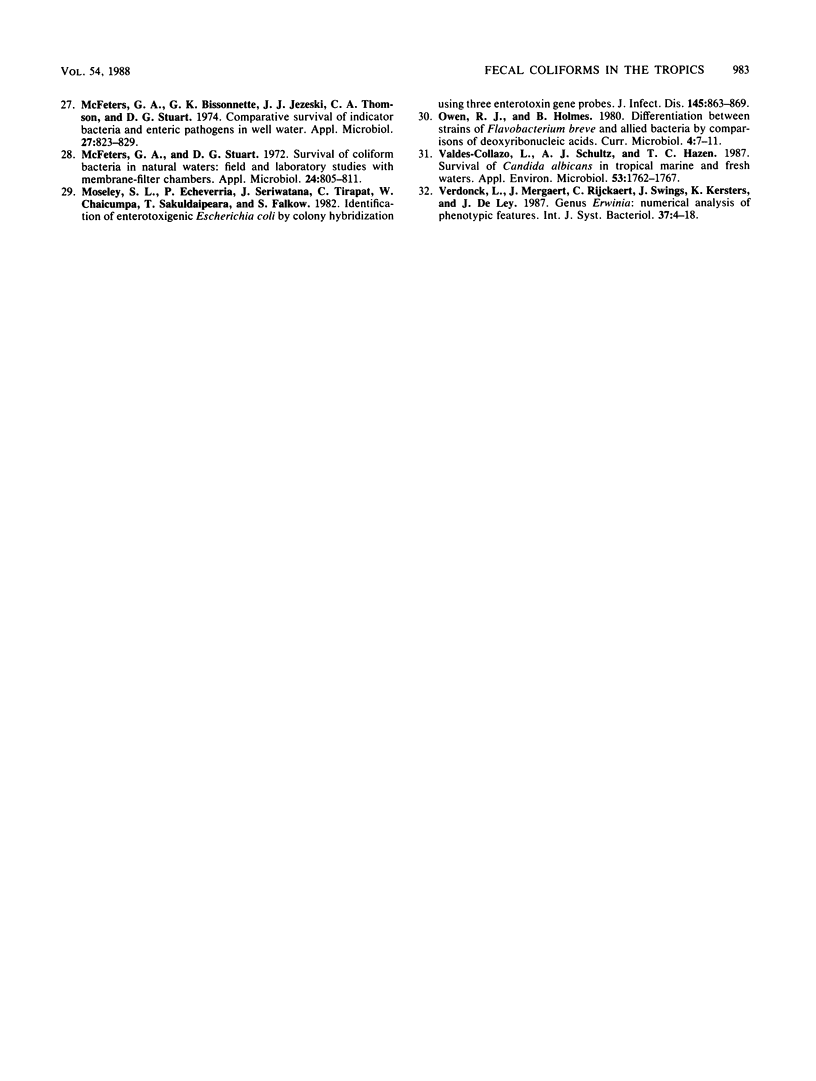Abstract
Nine fecal-coliform-positive strains were isolated from pristine sites in a tropical rain forest. These sites included nonpolluted rivers and water from bromeliads (epiphytes) which were 30 ft (ca. 910 cm) above the ground. Phenotypically, all of these isolates were identified as Escherichia coli. Their DNA was isolated and purified, and the base composition (G + C content) was determined and compared with that of E. coli B (ATCC 11303). The DNA from the environmental isolates was also hybridized to radiolabeled DNA from E. coli B. Eight strains had a DNA base composition similar to that of E. coli B and gave more than 75% homology with E. coli B. One strain had a different DNA base composition and a relatively low percentage of homology with the reference strain. The finding of E. coli in pristine tropical waters suggests that this bacterium could be a natural inhabitant in these environments and is not a reliable indicator of recent human fecal contamination in tropical waters. The indicators that are currently used in the tropics to test the biological quality of water should be reevaluated.
Full text
PDF




Selected References
These references are in PubMed. This may not be the complete list of references from this article.
- Bialkowska-Hobrzanska H. Detection of enterotoxigenic Escherichia coli by dot blot hybridization with biotinylated DNA probes. J Clin Microbiol. 1987 Feb;25(2):338–343. doi: 10.1128/jcm.25.2.338-343.1987. [DOI] [PMC free article] [PubMed] [Google Scholar]
- Brenner D. J., Fanning G. R., Skerman F. J., Falkow S. Polynucleotide sequence divergence among strains of Escherichia coli and closely related organisms. J Bacteriol. 1972 Mar;109(3):953–965. doi: 10.1128/jb.109.3.953-965.1972. [DOI] [PMC free article] [PubMed] [Google Scholar]
- Carrillo M., Estrada E., Hazen T. C. Survival and enumeration of the fecal indicators Bifidobacterium adolescentis and Escherichia coli in a tropical rain forest watershed. Appl Environ Microbiol. 1985 Aug;50(2):468–476. doi: 10.1128/aem.50.2.468-476.1985. [DOI] [PMC free article] [PubMed] [Google Scholar]
- Denhardt D. T. A membrane-filter technique for the detection of complementary DNA. Biochem Biophys Res Commun. 1966 Jun 13;23(5):641–646. doi: 10.1016/0006-291x(66)90447-5. [DOI] [PubMed] [Google Scholar]
- Edelstein P. H. Evaluation of the Gen-Probe DNA probe for the detection of legionellae in culture. J Clin Microbiol. 1986 Mar;23(3):481–484. doi: 10.1128/jcm.23.3.481-484.1986. [DOI] [PMC free article] [PubMed] [Google Scholar]
- Festl H., Ludwig W., Schleifer K. H. DNA hybridization probe for the Pseudomonas fluorescens group. Appl Environ Microbiol. 1986 Nov;52(5):1190–1194. doi: 10.1128/aem.52.5.1190-1194.1986. [DOI] [PMC free article] [PubMed] [Google Scholar]
- Fitts R., Diamond M., Hamilton C., Neri M. DNA-DNA hybridization assay for detection of Salmonella spp. in foods. Appl Environ Microbiol. 1983 Nov;46(5):1146–1151. doi: 10.1128/aem.46.5.1146-1151.1983. [DOI] [PMC free article] [PubMed] [Google Scholar]
- Hill W. E., Madden J. M., McCardell B. A., Shah D. B., Jagow J. A., Payne W. L., Boutin B. K. Foodborne enterotoxigenic Escherichia coli: detection and enumeration by DNA colony hybridization. Appl Environ Microbiol. 1983 Apr;45(4):1324–1330. doi: 10.1128/aem.45.4.1324-1330.1983. [DOI] [PMC free article] [PubMed] [Google Scholar]
- Kuritza A. P., Getty C. E., Shaughnessy P., Hesse R., Salyers A. A. DNA probes for identification of clinically important Bacteroides species. J Clin Microbiol. 1986 Feb;23(2):343–349. doi: 10.1128/jcm.23.2.343-349.1986. [DOI] [PMC free article] [PubMed] [Google Scholar]
- Lavoie M. C. Identification of strains isolated as total and fecal coliforms and comparison of both groups as indicators of fecal pollution in tropical climates. Can J Microbiol. 1983 Jun;29(6):689–693. doi: 10.1139/m83-112. [DOI] [PubMed] [Google Scholar]
- MARMUR J., DOTY P. Determination of the base composition of deoxyribonucleic acid from its thermal denaturation temperature. J Mol Biol. 1962 Jul;5:109–118. doi: 10.1016/s0022-2836(62)80066-7. [DOI] [PubMed] [Google Scholar]
- McFeters G. A., Bissonnette G. K., Jezeski J. J., Thomson C. A., Stuart D. G. Comparative survival of indicator bacteria and enteric pathogens in well water. Appl Microbiol. 1974 May;27(5):823–829. doi: 10.1128/am.27.5.823-829.1974. [DOI] [PMC free article] [PubMed] [Google Scholar]
- McFeters G. A., Stuart D. G. Survival of coliform bacteria in natural waters: field and laboratory studies with membrane-filter chambers. Appl Microbiol. 1972 Nov;24(5):805–811. doi: 10.1128/am.24.5.805-811.1972. [DOI] [PMC free article] [PubMed] [Google Scholar]
- Moseley S. L., Echeverria P., Seriwatana J., Tirapat C., Chaicumpa W., Sakuldaipeara T., Falkow S. Identification of enterotoxigenic Escherichia coli by colony hybridization using three enterotoxin gene probes. J Infect Dis. 1982 Jun;145(6):863–869. doi: 10.1093/infdis/145.6.863. [DOI] [PubMed] [Google Scholar]
- Valdes-Collazo L., Schultz A. J., Hazen T. C. Survival of Candida albicans in tropical marine and fresh waters. Appl Environ Microbiol. 1987 Aug;53(8):1762–1767. doi: 10.1128/aem.53.8.1762-1767.1987. [DOI] [PMC free article] [PubMed] [Google Scholar]


